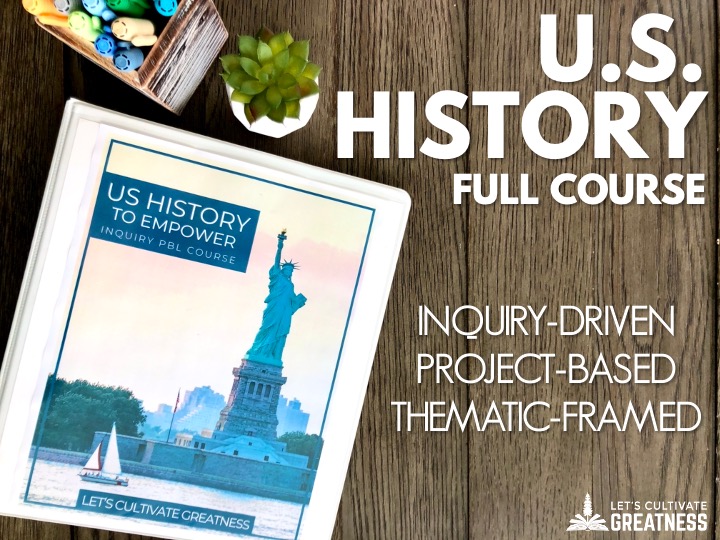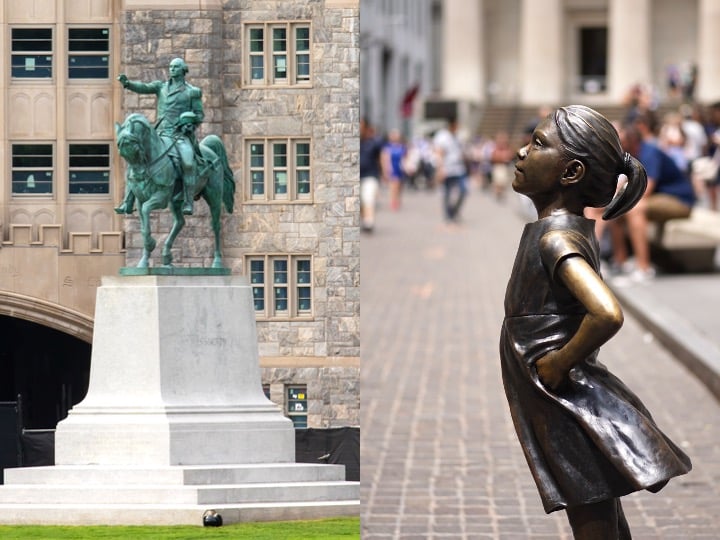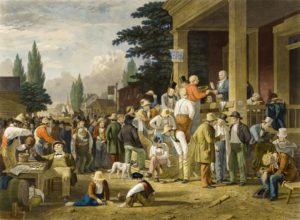So, you’re interested in teaching history more thematically, but not quite ready to commit?
Or you’re following a strict scope and sequence, but want to zoom out at least a little from the rapid-fire timeline?
I got you.
In this blog post, I’m sharing 5 different thematic inquiry questions that will give you some options to help you frame out your whole US History course. Each one also comes with concrete ideas for implementation.
These questions are ones you could pose the first week of school with a one-day activity, tie each unit back to, and culminate with a year-end project that challenges your students.
You could even incorporate the themes into your classroom décor with related bulletin boards and posters.
Creating a year-long theme was my first venture into teaching US History thematically, before I even really knew what thematic history was. All I knew was that throughout our year we kept talking about the same broad things, asking the same no-right-answer questions, and constantly making connections to present day.
So, let’s dive in to my 5 favorite year-long inquiry questions for adding a thematic element to your US History course.
Do we live up to the Constitution’s Preamble?
Start-of-the-year activity idea: Conduct a close read of the Preamble, clause by clause, defining words and discussing examples of how the government and American society today uphold (and don’t quite uphold) each. Hold an informal discussion or free-write asking students to answer the question based on their incoming ideas.
If you have extra time, share how the preamble serves as the nation’s unofficial mission statement, talking about the criteria of a good mission statement (it does a fairly decent job of checking the boxes, despite mission statements not being a thing in the eighteenth century!). Then, have students write their own mission statements for the year.
Throughout the course: Each unit, ask students which clauses the government is attempting (or failing) to fulfill at that time. For example, “insure domestic Tranquility” and “promote the general Welfare” in your Civil Rights Movement unit.
End-of-the-year project idea: Hold a class discussion and/or extended writing answering the question. Then, have students propose a clause they believe should be added, based on historical and present-day events. This essay could even take the shape of an Op-Ed essay they submit to the local newspaper.
How well do we fulfill America’s founding values?
Start-of-the-year activity idea: Ask students what they believe are America’s values, or simply give them a list and have them talk about what each means and give examples of them in present-day.
This theme is one I use in my first unit specifically on America’s founding values and so I provide a list to the students since the unit is framed on them. I call them the “Core FORE”: Freedom, Opportunity, Representation, and Equality.
I learn a lot about my students and their incoming knowledge and beliefs from this activity, which is why I like it so much. Plus, students end up still referencing the Core FORE even into the next year when I’m teaching them in Civics. Talk about “stickiness” of thematic teaching!
Throughout the course: Designate a main value for each unit. For example, opportunity for your Gilded Age unit, then representation for your Progressive Era unit and talk about how people in that era grappled with, shifted towards, or fought for that value.
End-of-the-year project idea: Have students research a present-day issue related to one of the values and write a letter to their elected official or a letter to the editor of the local newspaper.
Pro tip: keep an eye on the Op-Ed page of your paper. It is so common to see essays refer to America’s foundational values, making them great examples to share for this project.
What is America’s story?
Start-of-the-year activity idea: Read a few short children’s biography books of Americans who will come up throughout your course. Have students determine the takeaway lessons or themes from them, which are usually fairly clear. Perhaps, a Harriet Tubman book really frames her story as one about courage. Or a Thomas Edison book speaks of determination and innovation.
Have students share and reflect on how these traits are celebrated in larger American culture. Then collectively develop a short list of these “most-American” traits. Hang this on the wall for continual reference.
Throughout the course: As you cover different Americans and their lived experiences, have students think and talk about which traits they each exhibit from the posted list. When you get to those people from the children’s books they read, ask students if their perceptions about them have changed now knowing so much more about them.
End-of-the-year project idea: Hold a superlative awards ceremony in which students research, present, and defend their awarding of titles to people you’ve studied; for example the Most Courageous or Most Innovative Americans.
How do we remember America’s past?
This one is great when teaching the first half of US History, through Reconstruction.
Start-of-the-year activity idea: Share photos of the statues and memorials in your community and their origin stories. Discuss how all statues reveal two times in history: the historical event or person’s accomplishments and then the era in which the statue was put up. Statues and memorials are created out of a desire to remember, meaning there must be a sense that they have been forgotten or are in need of proper recognition.
You can also share and discuss national monuments—like Mount Rushmore (Why those presidents?) or the World War II Memorial in Washington, D.C. (Why did it take until the 1990s to birth the idea for it?)
Throughout the course: As you complete each unit, ask students who or what from that era deserves to be memorialized and investigate if they already are somewhere or somehow, either through statues, memorials, or historical markers.
End-of-the-year project idea: Have students research an event or person who doesn’t seem to get the recognition it or they deserve. Then, design a statue and write up a plaque to display as a part of a bulletin board. You could go further by having students further investigate the stories behind local statues and memorials and/or proposing new ones, including writing to local government agencies.
What makes an American hero?
This one is great for teaching the second half of US History, through modern history.
Start-of-the-year activity idea: Showcase a few Americans who have received the Presidential Medal of Freedom and talk about how they exemplify American heroism. In my class, we do a whole unit focused on what makes an American hero and we use these four traits: bravery, creativity, preparedness, and grit. The last few presidents have posted lists of their recipients with short paragraphs sharing their accomplishments, making it super easy for students to quickly assign traits. You could also do something similar with the Congressional Medal of Honor, which is the nation’s highest military honor.
Throughout the course: As you encounter historical people, have students label which heroic traits that person showed in the actions or words they chose.
End-of-the-year project idea: Have students pick a living American who they regard as a hero, research them, and write a short nomination for why they deserve the Presidential Medal of Freedom. Have students send them to you and submit them all as one to the White House.
I have done this nomination project for years and it is truly a great high note on which to end the year.
I hope these inquiry theme ideas have given you some inspiration for how you can incorporate a more thematic approach to your chronological US History class, especially if you trying a thematic approach for the first time. If you are looking for more plug-and-play resources or want to see fully thematic inquiry units in action, check out at my full-year US History course, which includes a free course overview download.

Feature image credits: David Lowe and Jouwen Wang





